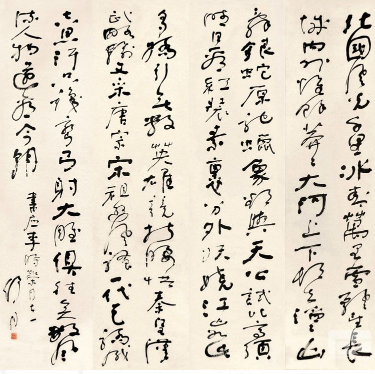收购名人字画作为一种保值增值的投资行为,其投资效益往往比别的项目更显着,其增值幅度也超过别的投资。它的特殊性在于书画艺术品不仅是一种物质存在;而且是一种精神文化的结晶,既可作为一种物资财富储蓄,也可作为艺术来欣赏与研究。书画的价值又具有相对的稳定住,表现在奇货可居,永不过时,天增岁月画增价。书画的买卖又随时可以进入拍卖市场,得到一个公平的。究竟什么样的字画具有收藏价值呢?
Acquisition of celebrity paintings as a value-preserving and value-added investment behavior, its investment benefit is often more significant than other projects, and its value-added range is also greater than other investments. Its particularity lies in that the art of painting and calligraphy is not only a material existence, but also a crystallization of spiritual culture, which can be appreciated and studied as both a material wealth savings and an art. The value of painting and calligraphy is relatively stable, which is reflected in the exotic goods, never outdated, increasing the price of paintings. The sale of calligraphy and painting can enter the auction market at any time and get a fair price. What kind of calligraphy and paintings have collection value?
名人字画有保值增值功能,远的不说,从新成立以来,我国名家字画的增幅是有目共睹的。
Celebrity calligraphy and painting has the function of preserving value and increasing value. Far from that, since the founding of New China, the price increase of Chinese famous calligraphy and painting is obvious to all.
20世纪50年代,张大千的一般作品在国内仅卖数十元,精品不过百元,如他的《仿周文矩洗婴图》、《秋林载洒图》等在北京售价为100元一幅。
In the 1950s, Zhang Daqian's general works only sold for tens of yuan in China, but his fine works were less than 100 yuan. For example, his Baby Washing Pictures Imitating Zhou Wenzhong and Spraying Pictures in Autumn Forest sold for 100 yuan each in Beijing.
20世纪60年代中期,傅抱石巨幅《山水》画标价80元,齐白石标的画价100元。到改革开放初期,有关部门规定收购着名画家的作品为15元一平方尺,到20世纪80年代初为100元一平方尺,以后又调整5001000元。
In the mid-1960s, the price of Fu Baoshi's huge painting Landscape was 80 yuan and Qi Baishi's painting was 100 yuan. At the beginning of reform and opening up, the relevant state departments stipulated that the purchase of famous painters'works was 15 yuan per square foot, and in the early 1980s it was 100 yuan per square foot, and then it was adjusted to 500 to 1000 yuan.

20世纪60年代初,王雪涛一张五尺大幅精品售价23元,徐悲鸿着名的《松鹰图》售价230元。
In the early 1960s, Wang Xuetao sold a five-foot boutique for 23 yuan, while Xu Beihong's famous Pine Eagle Tu sold for 230 yuan.
1990年3月19日,李可染的力作《烟江夕照》在香港创下100万元的成交价,突破了百万元大关。后又有多幅作品突破百万元的记录。1993年他的《五牛图》在佳士得拍卖会上,被一买家已103.5万港元竞得;1998年他的代表作《九牛图》在太平洋拍卖会上,经过买家的激烈竞拍,在300万元的价位上一锤定音,加上佣金合计要330万元。1999年他的力作《万山红遍》在嘉德拍卖会上被拍407万元,创造了李可染作品当时的市场价。现在,李可染已有5幅画作拍卖成交价过亿。
On March 19, 1990, Li Keran's masterpiece "Yan Jiang Xizhao" set a transaction price of 1 million yuan in Hong Kong, breaking through the $1 million barrier for the first time. Later, there were more than one million records of works. In 1993, his "Wuniu Tu" was won by a buyer at Christie's auction for HK$1.035 million. In 1998, his masterpiece "JiuNiu Tu" was sold at the Pacific auction, after intense bidding by the buyer, and finally settled at the price of RMB3 million, with a total Commission of RMB3.3 million. In 1999, his masterpiece Wanshan Hongpan was sold to 4.07 million yuan at the Jiade auction, creating the highest market price for Li Keran's works at that time. Now, Li Keran has sold five paintings at auction for over 100 million yuan.
现代山水大家李可染作品20世纪50年代在荣宝斋出售时,牛画作品为65元,山水作品为70元,这个基本维持到“文革”时期。改革开放后,李可染的作品开始大幅攀升,牛画定价由数千元上升到万元,山水画略高。1989年12月,李可染去逝后,有关部门规定,李可染画作一律禁止出口,在此规定的刺激下,李的作品再次大幅上升。
When Li Keran's works were sold in Rongbaozhai in the 1950s, the cattle paintings were 65 yuan and the landscape paintings were 70 yuan, which basically maintained until the "Cultural Revolution". After the reform and opening up, Li Keran's works began to rise sharply. The price of cattle painting rose from thousands of yuan to ten thousand yuan, and landscape painting was slightly higher. In December 1989, after the death of Li Keran, the relevant departments stipulated that all Li Keran paintings were banned from export. Stimulated by this regulation, Li Keran's works rose again.
本文来自:收购名人字画!希望通过我们的讲解对大家都有所帮助!更多的内容欢迎点击:http://www.jinandayatang.com我们将会对您提问的问题提供一个满意的回复,欢迎您的来电!
This article comes from: Acquisition of celebrity calligraphy and painting! I hope that our explanation will be helpful to all of you! More content welcome click: http://www.jinandayatang.com, we will provide a satisfactory answer to your questions, welcome your call!
